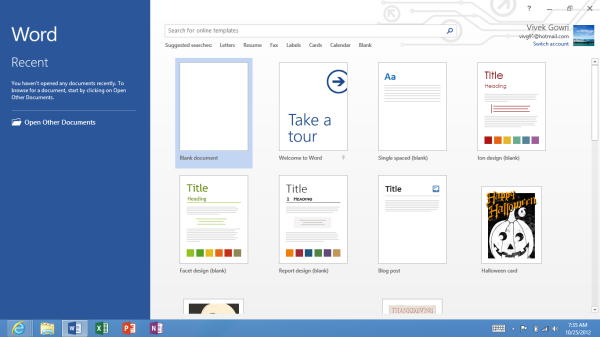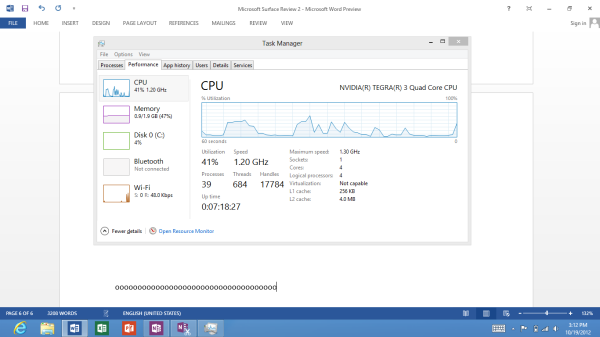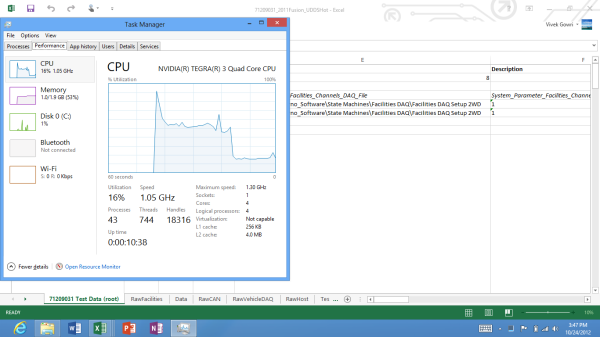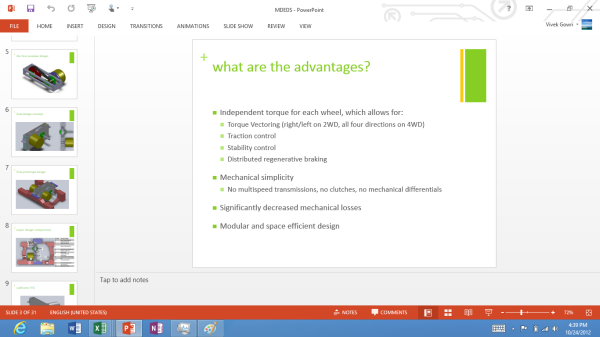The Windows RT Review
by Vivek Gowri & Anand Lal Shimpi on October 25, 2012 12:00 PM EST- Posted in
- Windows RT
- Operating Systems
- Microsoft
- Mobile
- Windows 8
- Tablets
Office 2013 for Windows RT
Office 2013 is the headlining application for Windows RT. And it’s a pretty big deal - this is the first time we’re seeing the full Office experience reach a modern tablet platform, at least in the first party sense. In the smartphone world, this wasn’t as much of a distinguishing factor as Microsoft hoped it would be when they included a mobile version of the full Office suite in Windows Phone 7, but that’s because there’s relatively little scope for document creation or editing on handhelds. In the tablet world though, it’s huge. For a tablet to truly be a viable replacement for a notebook, office productivity needed to be addressed.
So Microsoft decided to do something about it: Office 2013 Home and Student Edition ships as a pre-installed part of every single Windows RT tablet. And just like that, almost every non-engineering student I know could get away with a Windows RT tablet as their primary computing device, provided they aren’t gamers or aren’t attached to the idea of local storage. It’s something I couldn’t say about the iPad or any of the Android tablets out there. But I’m getting ahead of myself here. Let’s look at the applications themselves.
Office Home and Student contains Word, Excel, PowerPoint, and OneNote, so you get the core three productivity applications, as well as the one with the most potential for tablets. The one application that will probably be missed most is Outlook, but with Outlook account support for both the Mail and Calendar apps, enough of the functionality is still available. Outlook is more power-user oriented than either Mail or Calendar, but when it comes down to it, Windows RT was created to serve a more consumer-oriented market segment that typically doesn’t rely on the more intricate functionality of Outlook.
Design was always the biggest question about creating a mobile office suite. How much would Microsoft be willing to change the interface to suit a touchscreen input? How much functionality would that give up? How would Excel even work? I don’t actually have an answer, but here’s where the thinking went: why bother designing a touch-centric typing or spreadsheet app if most people are going to turn to a physical keyboard to use it anyways? And it’s a line of reasoning that makes sense - beyond going completely to voice control, I cannot see myself using any word processor without touching a physical keyboard. And many of the more complex functions of Excel, like formulas and macros, would be near impossible to replicate on a touch-centric UI without neutering a decent amount of the power and control users have.
So, instead of redesigning Office to fit within the new Modern UI guidelines, Microsoft simply ported the x86 version of Office 2013 over to ARM and runs it as a desktop application. I can’t blame them - Office 2013 was redesigned with the Metro design language, so it already fit the Windows RT visual style, and it was just easier for them to not mess with the UI or UX further. But that’s actually a good thing - Office is the killer application for RT because it functions exactly the same as Office 2013 on any other system. If you live in the world of Office 2013 and SkyDrive, this is fantastic news because you need to make almost no adjustments to your workflow. It’s just as capable and powerful on here as it is on any other Windows system.
Office isn’t perfect, and you can level any number of complaints at it - aggravating at times, uses proprietary file formats, resource intensive, expensive, difficult to learn, and I’m only scratching the surface. Based on my usage of the Office 2013 Preview on Windows 7 and RT, it’s actually my favorite version yet, so there’s that, but the main point is that this is still a full-fledged version of Office that we’re talking about here. Over the last two decades, people have learned to put up with its quirks and faults, and it’s still one of the single most important pieces of productivity software on the market.
So, how does it all work? Pretty well, all things considered. All of these applications are pretty much exactly as you would find on an x86 PC, so I’m not going to go very far into the design and functionality, though there are a couple of interesting use-cases that I’ll bring up later on. The most critical concern I had going into Office on ARM was performance - the reputation for being a resource-intensive software suite is not undeserved, let’s put it that way, and quad-core A9, great as it is, doesn’t have the raw compute horsepower of Atom much less Core 2 or any newer Intel processor.
In Word, it’s relatively easy to pull 30% CPU utilization when typing quickly. Anand saw up to 40% on Surface, and I managed to get CPU utilization all the way up to 55% when pressing random keys as quickly as possible. Compare this to Notepad, which usually hovers in the 5-10% CPU utilization range, and it’s clear to see how heavy a load Office puts on the system. Even with the high CPU utilization though, I never saw any lag in the characters appearing, so it’s mostly an interesting point to note and not an issue with the typing experience.
Update: Microsoft shared an official response with us about the high CPU utilization we're seeing:
Increases in CPU utilization while typing are an expected behavior in Word, but should not extend beyond the immediate typing. However, we are always looking at ways to improve CPU utilization and the customer experience with Office.
To really push the system, I loaded up some of the Excel files I work with at my real life job as an automotive technology researcher. These are raw and mostly unprocessed dynamometer data test files, with roughly 3 million data cells each (give or take.) The largest had just under 4 million data cells and was 39MB in size, smallest about 1.8 million and 19MB in size. A couple of graphs and some equations. Together, the four files totaled 112MB. I decided to open all four at once - it took about a minute and a half, with a max CPU load of 72%. It was crazy, but once everything was loaded, performance was actually decent. I wouldn’t want to necessarily work on the files for extended periods with a system like this - the screen is too small, and the couple of bits of lag would drive me nuts (plus, without Matlab, it’s a bit pointless) but for quick graphing of basic data, it works significantly better than expected.
The good thing is that there’s a lot of RAM here - with 2GB seeming to be the default for Windows RT tablets you’re rarely memory starved. So even with 250MB worth of RAM dedicated to Excel, CPU headroom is still the main limiting factor. For more basic Excel tasks, like the chemistry labs that were commonly assigned in undergrad, there’s definitely more than enough power here. The files I loaded up are typically only manipulated on quad-core workstation notebooks and are far and away an extreme use case.
I didn’t really spend a whole lot of time in PowerPoint, because I typically don’t use it very much. I loaded up a presentation I gave late last year about some of my research at the time, and started editing it to see if the experience had anything different to mention. Performance seemed good enough, with maybe a hint of frame drop when scrolling through the slide thumbnails on the right edge (it moves at something closer to 25 FPS than 30). I liked the ability to swipe back and forth between slides when in Presentation mode, that’s one nice thing about the tablet interface. Other than that, this is just PowerPoint on a smaller screen.
OneNote is the one that I was really interested in. Because even though it runs within the framework of the Windows desktop, it’s an application that really lends itself to tablet usage. Back in the tablet PC days, OneNote was the killer usecase, the one program that really lent itself to being used in conjunction with pen-input. I came very close to buying a Wacom-enabled tablet on numerous occasions for the specific purpose of taking electronic lecture notes with OneNote. (It never happened, and I ended up taking very few notes of any kind through college, but such is life.)
Now, without active digitizer support on most Windows RT tablets (I haven’t seen any with active digitizers), you’re limited to either keyboard or capacitive touch input. This is where the handwriting panel comes in, and like I mentioned before, it’s quite good even when you’re just using your finger to write. With a capacitive stylus (which I regrettably do not have on hand) I can see this being legitimately useful to take handwritten notes on. It’s good enough that you can get away without a Wacom-enabled tablet if you don’t want to shell out the extra $400 or so. I genuinely wish something like this was available when I was still in the notetaking phase of college, many moons ago - the fifteen year old me would have killed to have a $600 tablet with solid handwriting recognition, even without an active digitizer.
And that’s really what makes Office for Windows RT interesting. It gives you 95% of the office suite experience and capability of any normal desktop or notebook PC in the modern tablet form factor, introducing some much needed productivity into what was previously a very content-consumption oriented device category.















233 Comments
View All Comments
steven75 - Friday, November 2, 2012 - link
iPad 4-finger swipe is pretty damn fast. I'm not sure how it could be faster.eaanders22 - Thursday, October 25, 2012 - link
Microsoft has managed to clutter up what could have been a decent tablet with remnants of an aging operating system. Can you imagine Apple putting a few hooks to the OSX desktop into its iOS tablets that don't give much of the functionality of OSX? A DOS prompt in a tablet, give me a break!Let's face it. Tablets are basically big phone technology. They're not computers in any real sense. Apple recognized this. They had a successful phone and they configured a tablet from it. Doing any significant input or serious analysis on a phone or tablet is a non-starter. You need a decent keyboard and special purpose software for many different kinds of tasks a full blown computer can do.
There is a third approach. Windows and OSX have become beasts of the tech world with complicated user interfaces to give the flexibility and power to do complicated tasks. An alternative to the phone/tablet approach, which is basic output only driven, are devices like the Chromebook which relieve casual users of burden of complexity by doing most of the work in the cloud. This dramatically reduces the learning curve for new users and frees them of the busy work of backups, updates, and security considerations. It can mean cheap, light weight systems with no moving parts that perform both input and output in the simplest possible way. Novice users are put off by the complexity of full blown computers and even by the complexity of modern smartphones and tablets.
Microsoft could have been successful by keeping RT a tablet version of Windows Phone and coming out with a web based verson of Windows like Chromebook. These devices haven't taken off like tablets due to the fact that the user experience with phones easily transferred to tablets, while Google didn't have a base in the full blown computer world to build on. But, there is an audience out there, particularly new users and older users that are tired of putting up with the complexity, lag, and busywork associated with bloated full blown operating systems they don't need to do a little writing, emailing, and multimedia watching. The new $249 Samsung Chromebook that just came out sold out everywhere in a couple days. The new RT devices are twice as costly and twice as complicated to get up to speed on for people looking to continue their quite simple use of a computer for a little emaling, writing, and multimedia watching. Who needs a touch screen for that. It just gets in the way.
The Windows 8 systems are another story. There you get full computing power and the functionality of a tablet in one package. This will fit a wide audience of sophisticated computer and smartphone users.
Dorek - Friday, November 2, 2012 - link
"A DOS prompt in a tablet, give me a break!"Uh, I think it's awesome. It lets you do a lot that iOS could never, ever do.
Chromebooks are never giong to take off. Can you even sync an iPod to a Chromebook?
Shadowmaster625 - Thursday, October 25, 2012 - link
Eventually someone is going to release either a compiler or binary translator or emulator or something that lets you convert a visual studio project to RT. Or even run the x86 executable itself. Right? I should be able to compile my own sleep.exe and launch it from a batch file. How can they stop that, and why would they?andrewaggb - Thursday, October 25, 2012 - link
They might require all apps to be signed to be run. Any apps in the store could be signed by them and any apps that come with windows could be.It would really make it hard to get viruses etc but it would also stop compiling your own without going through the store.
I don't really know what measures are active though.
Jugklutzz - Thursday, October 25, 2012 - link
Hey Guys. Great review.Tablets play a huge base in cloud base storage. What are the options for mounting a NAS?
Best Regards,
Mike
mattlach - Thursday, October 25, 2012 - link
RT does nothing for me.Main reason I have not bought a tablet is because of both Android and iOS not being able to run full featured desktop software.
To me the brilliance of Windows 8 is what it does for x86 tablets, that can be both for full desktop use AND tablet use.
We don't need another limited tablet OS like Android and iOS. RT Is a complete waste IMHO.
THizzle7XU - Thursday, October 25, 2012 - link
"If you’re really concerned about the state of third-party apps, you just have to wait and see. I’ve seen a lot of snap judgements made about Windows RT in the last couple of days based on the dearth of good applications in Windows Store, and while I agree with that sentiment, I feel like it’s extremely shortsighted to write off the ecosystem already. Neither version of the OS has gone on sale yet, and we know that there are a number of applications that will go live on the official release date, as well as many more coming in the weeks ahead."Exactly what I was thinking when reading the complaints on The Verge and some other sites. They claim there are no apps, and I'm thinking...well, technically there is no Windows RT yet for anyone because it's not out yet! And as a developer, I know how they think. Why release something earlier than you have to? You want as much time as possible to work on code and QA. If no one but some media and beta testers don't have the OS yet, what's the rush to release a version 1.0 app? So these sensationalist pseudo-tech editors can rip your early app apart too?
nofumble62 - Thursday, October 25, 2012 - link
Apps launch time is too slow for my patience.Haswell convertible laptop would be a killer.
Tablet and laptop will converge next year.
gsurath - Friday, October 26, 2012 - link
Fantastic review. From this point of view I can now clearly see corporate boardrooms across the world with RT based tablets sitting on the desks. I can see people carrying them all around the office. I think that is where RT will win big. I see corporates creating their own RT apps for employees to access. This review along with Anand's on Surface reconfirms to me that Windows has just paved the way to dominate the office market for a few years to come. Will this mean that people will then use this single device across all their needs? No so sure given the number of gadgets we tend to collect, I still think will find a space. With Office 2013 for ARM being made available, Android too will have the capabilities of RT in the future. All in all, the future is interesting.